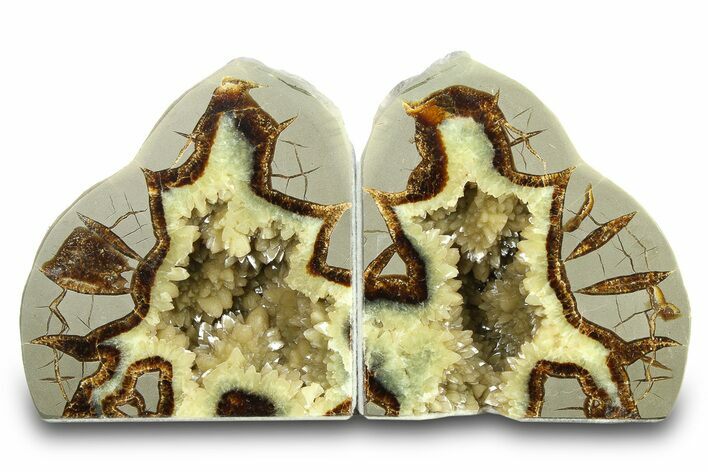5.7" Crystal Filled Septarian Geode Bookends - Utah
This is a pair of gorgeous crystal filled bookends made from a cut and polished septarian geode. The septarian was mined West of Orderville, Utah and was deposited during the Late Cretaceous, about 100 million years ago. The patterns made by the yellow calcite crystals, brown aragonite, and grey limestone are stunning. The calcite exhibits a vibrant fluorescence under short-wave ultraviolet light.
The edges of the bookends have been lined with felt.
The edges of the bookends have been lined with felt.
About Septarian
Septarian or septarian nodules are concretions containing angular cavities or cracks, called "septaria", filled with calcite and aragonite. A concretion is a hard, compact mass of rock that often forms around decaying organic matter. In the case of septarian nodules, the concretions formed around decaying sea life in a marine environment.
The exact mechanism for how the cracks form in the concretions is a mystery. One possible mechanism is the dehydration of the clay-rich core of a concretion, causing it to shrink and crack. The cracks could also be caused by gas expansion produced by the decaying organic matter within a concretion. Earthquakes have also been suggested as yet another mechanism.
The cracks in the concretions are then filled in with minerals such as calcite (yellow), aragonite (brown), and sometimes pyrite, causing very interesting patterns. They have often been described as looking like dragon's skin. They are frequently found as geodes with hollow, calcite crystal-filled cavities. More rarely, the fossils that originally started the formation of the concretion are still preserved in the septarian.
Septarian or septarian nodules are concretions containing angular cavities or cracks, called "septaria", filled with calcite and aragonite. A concretion is a hard, compact mass of rock that often forms around decaying organic matter. In the case of septarian nodules, the concretions formed around decaying sea life in a marine environment.
The exact mechanism for how the cracks form in the concretions is a mystery. One possible mechanism is the dehydration of the clay-rich core of a concretion, causing it to shrink and crack. The cracks could also be caused by gas expansion produced by the decaying organic matter within a concretion. Earthquakes have also been suggested as yet another mechanism.
The cracks in the concretions are then filled in with minerals such as calcite (yellow), aragonite (brown), and sometimes pyrite, causing very interesting patterns. They have often been described as looking like dragon's skin. They are frequently found as geodes with hollow, calcite crystal-filled cavities. More rarely, the fossils that originally started the formation of the concretion are still preserved in the septarian.
$495
SPECIES
Septarian
LOCATION
West of Orderville, Utah
FORMATION
Frontier Formation
SIZE
5.7 x 4.7 x 2.65" (each)
CATEGORY
ITEM
#288943
 Reviews
Reviews











